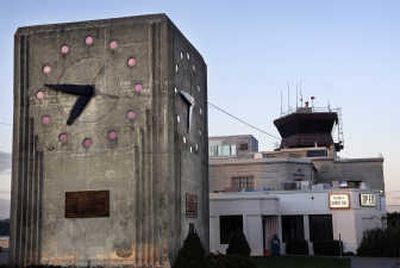Felts Field clock honors aviator Nick Mamer

Back in the day when wrist watches were wound daily, general aviation pilots flying out of Felts Field set their watches by the huge Nick Mamer Memorial Clock that has stood outside the main terminal since 1939.
It was pretty easy to do – even from the runway – as the monolithic poured concrete clock structure rose some 40 feet into the air from its 14-feet-square base.
Today, it may not have the same practical use of days past, but it remains an intriguing structure – enhanced by art deco pilasters formed by vertical fluting, and with a clock face on each of the four sides. Originally denoting numbers on the clock were red circles, which have now faded to pink.
Rose and Oregon grape bushes surround the base, framing a beautiful and unique memorial for Spokane pilot Nick Mamer, “Mr. Spokane Aviation,” who advanced long-distance endurance flight in America as no one had before him.
Beginning on Aug. 15, 1929, and accompanied by Art Walker, who acted as mechanic and refueling hose man, Mamer piloted his Buhl Airsedan biplane – named the Spokane Sun-God – from Spokane to San Francisco and on to New York City and back to Spokane again, all in five days and without ever landing in between. They were refueled in mid-air and set the following records:
“World record for nonstop flight mileage (10,000 air miles)
“First transcontinental refueling flight
“First night refueling flight
“First aerial refueling conducted above 8,000 feet
News accounts at the time called the flight, which was sponsored by the National Air Derby Association of Spokane, “the hottest thing yet in the aviation world.” It was reported that 10,000 spectators were on hand to witness Mamer’s heroic return after 120-plus hours aloft.
Among his other achievements, Mamer reportedly made the first flight over Glacier National Park in 1920. Also in the 1920s, he was credited with initiating scheduled air transportation between Spokane and Minneapolis/St. Paul – a route he would later fly as a pilot for Northwest Airlines (NWA) in the 1930s. He had owed Mamer Air Transport, Mamer-Shreck flying service and Northwest Transcontinental Airways – all based at Felts Field.
On Jan. 10, 1938, Mamer was piloting a NWA flight from Seattle to Chicago in a newly designed Lockheed Model 14H Super Electra when the plane went into a dive and crashed over the Bridger Range outside of Bozeman, Mont. All 10 on board died. It wasn’t pilot error; an investigation revealed that the tail structure on the new design failed due to a period of vibration, and as a result of that finding, rudders on all Super Electras underwent modifications.
The memorial clock was built in Mamer’s memory the very next year at a cost of $5,324. Funds were raised through a drive launched by state, civic, military and business leaders.
In a dedication ceremony May 30, 1939, then Gov. Clarence Martin, a friend of Mamer’s, gave the main tribute, and was quoted in news media coverage that he “never felt safer on the ground than I did with Nick Mamer in the air.” It was reported that thousands attended the event.
Chapter 79 of the Experimental Aircraft Association ( www.eaa79.org), housed at Felts Field just a few paces from the memorial clock, has quite a bit of Nick Mamer memorabilia, as does EAA member Jerry Turner, who operates a transportation museum at 24203 E. Dalke Ave. in Otis Orchards, which is filled with memorabilia and items from antique vehicles, planes, motorcycles, bicycles and boats – along with some actual aircraft. Admission to the museum is free.
Turner is now working on an effort to have Mamer’s remains moved from Seattle to Spokane, the city from which the aviation pioneer launched himself into aviation history. Anyone interested in helping with the project can reach Turner at (509) 226-3522 or www.nosref@peoplepc.com.